|
|
 |
Georges de Feure -- Click Here
|
|
1868-1928
French designer and painter. Son of a Dutch architect and a Belgian mother, he started out as an actor, costumier and then interior decorator in Paris. In 1894 at the Galerie des Artistes Modernes he exhibited watercolours and paintings of a moderate Symbolist style, typically depicting women in a manner reminiscent of Aubrey Beardsley work. Capturing the essence of the feminine spirit became his trademark. With Eugene Gaillard and Edouard Colonna he was selected by Siegfried Bing, founder of the Galeries de l Art Nouveau, to design rooms for his Pavilion Bing at the Exposition Universelle, Paris (1900). De Feure carpets, glassware and furniture designs for the boudoir and toilette were based on the theme of woman, emphasizing delicate lines and elegant sensuality. He later left Bing gallery and, as an independent designer, created vide-poche furniture, which contained hidden marquetry compartments. This furniture suggested notions of secrecy and coquetry, themes that de Feure pursued throughout his career. |
|
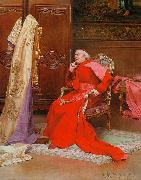 |
Georges Croegaert -- Click Here
|
|
1848-1923) was a Belgian academic painter. He was born in Antwerp, Belgium in 1848, and spent most of his life in Paris. Croegaert is associated with both classicism and anti-clerical art.
|
|
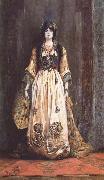 |
Georges Clairin -- Click Here
|
|
French Painter, 1843-1919
.French painter. In 1861 he entered the Ecole des Beaux-Arts in Paris, where he studied with Fran?ois Picot and Isidore Pils. He sent the first of many contributions to the Salon in 1866, an Episode of a Conscript of 1813 . By 1868 he had joined the painter Henri Regnault in a visit to Spain, where he was evidently impressed by Moorish architecture and influenced by the Spanish Orientalist painter Mariano Fortuny y Marsal; Clairin's Volunteers of Liberty: Episode from the Spanish Revolution was exhibited at the Salon of 1869 |
|
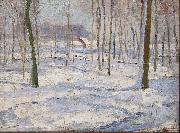 |
Georges Buysse -- Click Here
|
|
painted Winter Landscape in 19th century
|
|
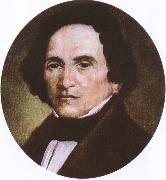 |
georges bizet -- Click Here
|
|
Born: Oct 25, 1838 in Paris, France
Died: Jun 03, 1875 in Bougival, France
Active: '30s, '50s, '70s-2000s
Major Genres: Music, Theater
Career Highlights: Carmen, Carmen Jones, Carmen
First Major Screen Credit: The Burlesque on Carmen (1916)
|
|
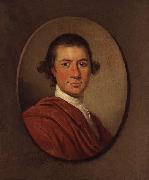 |
George Willison -- Click Here
|
|
Portrait painter who was born in Edinburgh in 1741 and returned there to spend his retirement.
He was a pupil of Mengs in Rome, before Mengs left for Madrid in 1761.
He painted "Boswell" in Rome in 1765 which is now in the Scottish National Portrait Gallery.
Willison was in London from 1767 and exhibited at the Scottish Academy between 1767 - 1770, and at the Royal Academy in 1771 and 1772.
He left London for an opulent retirement in Edinburgh around 1784.
|
|
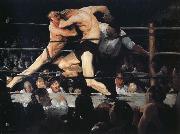 |
George Wesley Bellows -- Click Here
|
|
American Ashcan School Painter, 1882-1925
American painter and lithographer. He was the son of George Bellows, an architect and building contractor. He displayed a talent for drawing and for athletics at an early age. In 1901 he entered Ohio State University, where he contributed drawings to the school yearbook and played on both the basketball and baseball teams. In spring of his third year he withdrew from university to play semi-professional baseball until the end of summer 1904 |
|
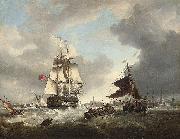 |
George Webster -- Click Here
|
|
Please search for George Webster (painter) in Wikipedia to check for alternative titles or spellings. |
|
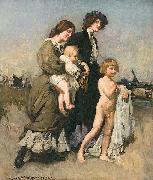 |
George Washington Lambert -- Click Here
|
|
(13 September 1873 - 29 May 1930) was an Australian artist, known principally for portrait paintings and as a war artist during the First World War.
Lambert was born in St Petersburg, Russia, the posthumous son of George Washington Lambert (1833 - 25 July 1873, in London) of Baltimore, Maryland. The younger Lambert's mother was Annie Matilda, nee Firth, an Englishwoman. Mother and son soon moved to Werttemberg, Germany, to be with Lambert's maternal grandfather. Lambert was educated at Kingston College, Yeovil, Somerset. The family, consisting of Lambert, his mother and three sisters, decided to emigrate to Australia. They arrived in Sydney aboard the Bengal on 20 January 1887. |
|
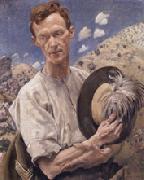 |
George W.Lambert -- Click Here
|
|
Russia-born Australian portrait painter
1873 - 1930
Australian painter, draughtsman and sculptor. He lived for a period in Europe and emigrated to Australia in 1887. He trained under Julian Rossi Ashton, gaining early recognition for his draughtsmanship. In 1901 he studied in Paris at the Acad?mie Colarossi under Auguste Del?cluse (b 1855). He was strongly influenced by the work of Diego Vel?zquez and Edouard Manet. The work of Sandro Botticelli later inspired him to paint in a high key and with an enhanced realism, as in Important People (1914; Sydney, A.G. NSW). He lived in England from 1902 to 1921 |
|
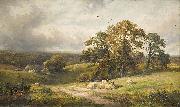 |
George Turner -- Click Here
|
|
1750-1843.
Turner was born in Cromford, Derbyshire in England, but then moved to Derby with his family. He showed an early talent for music and art - encouraged by his father Thomas Turner, who although a tailor by profession was also an art enthusiast. Turner was largely self-taught and went on to become a professional painter and art teacher.
A quiet scene in Derbyshire (1885)Turner lived in Derbyshire all his life. In 1865 he married Eliza Lakin (1837 - 1900), becoming a part-time farmer and raising four children at Walnut farm in Barrow upon Trent.[1] After Eliza's death in 1900, he moved to Kirk Ireton and later married fellow artist Kate Stevens Smith (1871-1964) - they set up home in Idridgehay where he died in 1910. His son William Lakin Turner (1867-1929) also became a landscape oil painter of repute.
Turner worked in oils and painted bucolic scenes mainly of his native Derbyshire, leaving an important legacy of hundreds of pictures depicting the English countryside before the coming of mechanisation, the motor car and urban expansion. His work was exhibited in Nottingham and Birmingham. Turner served on the Art Committee of Derby Art Gallery and both his and his son's paintings are included in the city's collection. |
|
|
|
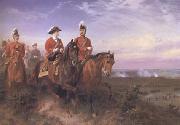 |
George Thomas -- Click Here
|
|
1816-1870
Union general in the American Civil War, b. Southampton co., Va. He served in the Seminole War and in the Mexican War. Later he taught at West Point and served in Texas. As a brigadier general of volunteers, he was sent to Kentucky, where he defeated the Confederates at Mill Springs (Jan., 1862). Thomas served under General Buell at Shiloh, Corinth, and Perryville. In the Chattanooga campaign, his stand on Sept. 20, 1863, which saved the Union army from complete rout, won for him the sobriquet Rock of Chickamauga. Appointed brigadier general in the regular army, he succeeded General Rosecrans in command of the Army of the Cumberland (Oct., 1863) and served under Ulysses S. Grant around Chattanooga and under General Sherman in the Atlanta campaign. With the fall of Atlanta (Sept., 1864), Grant ordered Thomas to pursue the army of General Hood into Tennessee. Although accused by Grant of moving too slowly, and threatened with the loss of his command, Thomas waited and finally defeated Hood at Nashville (Dec., 1864). |
|
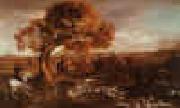 |
George Stubbs -- Click Here
|
|
1724-1806
George Stubbs Galleries
George Stubbs (born in Liverpool on August 25, 1724 ?C died in London July 10, 1806) was a British painter, best known for his paintings of horses.
Stubbs was the son of a currier. Information on his life up to age thirty-five is sparse, relying almost entirely on notes made by fellow artist Ozias Humphry towards the end of Stubbs's life. Stubbs was briefly apprenticed to a Lancashire painter and engraver named Hamlet Winstanley, but soon left as he objected to the work of copying to which he was set. Thereafter as an artist he was self-taught. In the 1740s he worked as a portrait painter in the North of England and from about 1745 to 1751 he studied human anatomy at York County Hospital. He had had a passion for anatomy from his childhood, and one of his earliest surviving works is a set of illustrations for a textbook on midwifery which was published in 1751.
In 1755 Stubbs visited Italy. Forty years later he told Ozias Humphry that his motive for going to Italy was, "to convince himself that nature was and is always superior to art whether Greek or Roman, and having renewed this conviction he immediately resolved upon returning home". Later in the 1754 he rented a farmhouse in the village of Horkstow,Lincolnshire, and spent 18 months dissecting horses. He moved to London in about 1759 and in 1766 published The anatomy of the Horse. The original drawings are now in the collection of the Royal Academy.
Even before his book was published, Stubbs's drawings were seen by leading aristocratic patrons, who recognised that his work was more accurate than that of earlier horse painters such as James Seymour and John Wootton. In 1759 the 3rd Duke of Richmond commissioned three large pictures from him, and his career was soon secure. By 1763 he had produced works for several more dukes and other lords and was able to buy a house in Marylebone, a fashionable part of London, where he lived for the rest of his life.
Whistlejacket. National Gallery, London.His most famous work is probably Whistlejacket, a painting of a prancing horse commissioned by the 2nd Marquess of Rockingham, which is now in the National Gallery in London. This and two other paintings carried out for Rockingham break with convention in having plain backgrounds. Throughout the 1760s he produced a wide range of individual and group portraits of horses, sometimes accompanied by hounds. He often painted horses with their grooms, whom he always painted as individuals. Meanwhile he also continued to accept commissions for portraits of people, including some group portraits. From 1761 to 1776 he exhibited at the Society of Artists, but in 1775 he switched his allegiance to the recently founded but already more prestigious Royal Academy.
Stubbs also painted more exotic animals including lions, tigers, giraffes, monkeys, and rhinoceroses, which he was able to observe in private menageries. He became preoccupied with the theme of a wild horse threatened by a lion and produced several variations on this theme. These and other works became well known at the time through engravings of Stubbs's work, which appeared in increasing numbers in the 1770s and 1780s.
Mares and Foals in a Landscape. 1763-68.Stubbs also painted historical pictures, but these are much less well regarded. From the late 1760s he produced some work on enamel. In the 1770s Josiah Wedgwood developed a new and larger type of enamel panel at Stubbs's request. Also in the 1770s he painted single portraits of dogs for the first time, while also receiving an increasing number of commissions to paint hunts with their packs of hounds. He remained active into his old age. In the 1780s he produced a pastoral series called Haymakers and Reapers, and in the early 1790s he enjoyed the patronage of the Prince of Wales, whom he painted on horseback in 1791. His last project, begun in 1795, was A comparative anatomical exposition of the structure of the human body with that of a tiger and a common fowl, engravings from which appeared between 1804 and 1806.
Stubbs's son George Townly Stubbs was an engraver and printmaker. |
|
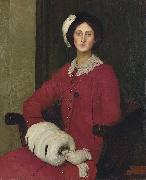 |
George Spencer Watson -- Click Here
|
|
R.O.I., R.P., A.R.A., R.A. (8 March 1869, London - 11 April 1934, London) was an English portrait artist of the late romantic school who sometimes worked in the style of the Italian Renaissance. He studied at the RA Schools from 1889, exhibited at the Royal Academy from 1891. He won Royal Academy Schools Silver Medals in 1889 and 1891, and the Landseer Scholarship in 1892. He was elected R.O.I. in 1900, R.P. in 1904, A.R.A. in 1923, and a Member of the Royal Academy (R.A.) in 1932.
He married Hilda, a dancer and mime artist, and follower of the actor Edward Gordon Craig. They had a daughter, Mary Spencer Watson (1913 - 2006), who became a sculptor. In 1923 he bought Dunshay Manor in the hills of the Isle of Purbeck, after already have spent holidays in Swanage.
He died in London and a memorial exhibition was held at the Fine Art Society in the same year. There is a memorial to him in the north vestibule of St James's Church, Piccadilly, London.
Some of his works are held at Tate Britain, the Harris Art Gallery, Preston and collections in Bournemouth, Liverpool, Plymouth and the National Gallery of Canada. Born in London, Watson studied at the Royal Academy from 1889; he exhibited there from 1891 and also at the Paris salon. Retrospective exhibitions were held at the Galerie Heinemann, Munich in 1912, and at the Fine Art Society in 1914. His work A Lady in Black (1922) is owned by the Tate Collection.
|
|
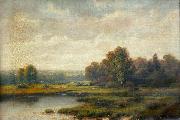 |
George Spencer -- Click Here
|
|
painted Hazy Afternoon in 19th Century
|
|
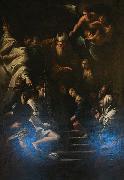 |
George Shuklin -- Click Here
|
|
painted Pyotr Drozhdin in 1745 |
|
|
|
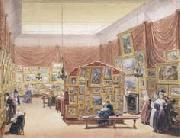 |
George Scharf -- Click Here
|
|
1820-1895
British art critic, was born in London, the son of George Scharf, a Bavarian miniature painter who settled in England in 1816 and died in 1860. He studied in the schools of the Royal Academy. In 1840 he accompanied Sir Charles Fellows to Asia Minor, and in 1843 acted as draughtsman to a government expedition to the same country. After his return he devoted himself with great industry and success to the illustration of books relating to art and antiquity, of which the best known are Macaulay's Lays of Ancient Rome (1847); Milman's Horace, (1849); Kugler's Handbook of Italian Painting (1851); and Dr Smith's classical dictionaries. He also engaged largely in lecturing and teaching, and took part in the formation of the Greek, Roman and Pompeian courts at the Crystal Palace. He acted as art secretary to the great Manchester Art Treasures Exhibition of 1857, and in that year was appointed secretary and director to the newly founded National Portrait Gallery. The remainder of his life was given to the care of that institution. Scharf acquired an unrivalled knowledge of all matters relating to historic portraiture, and was the author of many learned essays on the subject. In 1885 |
|
|
|
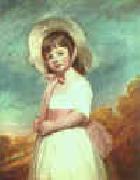 |
George Romney -- Click Here
|
|
1734-1802
George Romney Galleries
By 1757 he was becoming well-known as a portraitist. He fell ill during his apprenticeship and was nursed back to health by Mary Abbott, daughter of his landlady.
In 1762, by which time he was married with two children, he went to London, and saw early success with a painting, The Death of General Wolfe which won a prize from the Royal Society of Arts. Romney soon had a thriving portrait business in Long Acre.
Despite his great success George Romney was never invited to join the Royal Academy nor did he ever apply to join. While there has been much speculation about his relationship with the Academy there is no doubt that he normally remained aloof maintaining that a good artist should succeed without being a member. His own career certainly supported this belief and it was only towards the end of his life that he expressed the slightest regret for his views
Portrait of Miss Juliana Willoughby, 1781-83 (National Gallery of Art, Washington DC)
Emma Hamilton as a bacchante by George Romney, 1785In 1773 he travelled to Italy with fellow artist Ozias Humphrey to study art in Rome and Parma, returning to London in 1775 to resume business, this time in Cavendish Square (in a house formerly owned by noted portraitist Francis Cotes). In 1782 he met Emma Hamilton (then called Emma Hart) who became his muse. He painted over 60 portraits of her in various poses, sometimes playing the part of historical or mythological figures. He also painted many other contemporaries, including fellow artist Mary Moser. After an absence of almost forty years, he returned to his family in Kendal in the summer of 1799. He was greeted by his loyal, devoted and unquestioning wife. George Romney is a kinsman of Mitt Romney, U.S politician. |
|
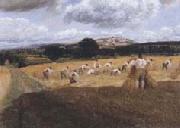 |
George Robert Lewis -- Click Here
|
|
English, 1782-1871 |
|
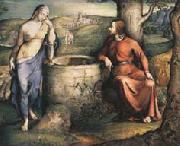 |
George Richmond -- Click Here
|
|
English Painter, 1809-1896
Painter, draughtsman and engraver. He was a precocious draughtsman. In 1824 he entered the Royal Academy, London, the same year as Edward Calvert, who was a part-time student of Joseph Severn. Richmond first exhibited at the Academy in 1825 and that year met William Blake in the Highgate house of John Linnell (ii). Like his lifelong friend Samuel Palmer, Richmond fell under Blake's spell, comparing him to the Prophet Isaiah and forming close friendships with Blake's other disciples, including Calvert. He visited Palmer at Shoreham, chiefly in the summer of 1827, and both he and Calvert became prominent members of Palmer's band of ANCIENTS, who frequented the Kent village in the late 1820s and early 1830s. The tempera panel Abel the Shepherd (1826; London, Tate) is typical of Richmond's early paintings, which reflect the pronounced influence of both Blake and Palmer. They are painted in an archaic style and include Christian and literary themes and high-minded if obscure genre subjects such as the Eve of Separation (1830; Oxford, Ashmolean). The human figure was central to these pictures as it was not for Palmer, who expressed sentiment through landscape motifs. Richmond was also active as a draughtsman and miniaturist during this period; his Christ-like head of Palmer, in watercolour and gouache on vellum (London, N.P.G.), dates from 1829. |
|
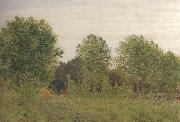 |
George Price Boyce.RWS -- Click Here
|
|
1826-1897
English painter. He was the son of a prosperous wine merchant and pawnbroker. His childhood was spent in London, and in 1846 he was apprenticed to the firm of architects Wyatt & Brandon, where he remained for three years. He was always fascinated by ancient buildings but gradually lost interest in architecture as a career. In 1849, perhaps as a result of meeting David Cox at Betws-y-Coed (Gwynedd, Wales), he decided to become a painter. In the early 1850s Boyce drew landscape and architectural subjects with a fluent watercolour technique derived from Cox. In 1854 Boyce made an extended journey to Italy; he painted views of buildings in Venice and Verona, which were commended by Ruskin, and semi-abstract twilight studies |
|
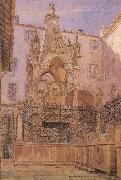 |
George Price Boyce,RWS -- Click Here
|
|
1826-1897
English painter. He was the son of a prosperous wine merchant and pawnbroker. His childhood was spent in London, and in 1846 he was apprenticed to the firm of architects Wyatt & Brandon, where he remained for three years. He was always fascinated by ancient buildings but gradually lost interest in architecture as a career. In 1849, perhaps as a result of meeting David Cox at Betws-y-Coed (Gwynedd, Wales), he decided to become a painter. In the early 1850s Boyce drew landscape and architectural subjects with a fluent watercolour technique derived from Cox. In 1854 Boyce made an extended journey to Italy; he painted views of buildings in Venice and Verona |
|
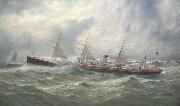 |
George Parker Greenwood -- Click Here
|
|
painted White Star Liner Adriatic in 1889 |
|
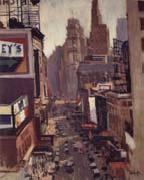 |
George Oberteuffer -- Click Here
|
|
American, 1878-1940 |
|
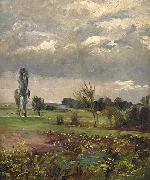 |
George Mosson -- Click Here
|
|
George Mason IV (December 11, 1725 - October 7, 1792) was an American Patriot, statesman and a delegate from Virginia to the U.S. Constitutional Convention. Along with James Madison, he is called the "Father of the Bill of Rights."[1][2][3][4] For these reasons he is considered one of the "Founding Fathers" of the United States.[5][6]
Like anti-federalist Patrick Henry, Mason was a leader of those who pressed for the addition of explicit States rights[7] and individual rights to the U.S. Constitution as a balance to the increased federal powers, and did not sign the document in part because it lacked such a statement. His efforts eventually succeeded in convincing the Federalists to add the first ten amendments of the Constitution. These amendments, collectively known as the Bill of Rights, were based on the earlier Virginia Declaration of Rights, which Mason had drafted in 1776.
On the nagging issue of slavery, Mason walked a fine line. Although a slaveholder himself, he found slavery repugnant for a variety of reasons. He wanted to ban further importation of slaves from Africa and prevent slavery from spreading to more states. However, he did not want the new federal government to attempt to ban slavery where it already existed, because he anticipated that such an act would be difficult and controversial.
|
|
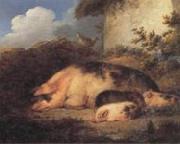 |
George Morland -- Click Here
|
|
English genre, animal, and landscape painter, 1763-1804
was an English painter of animals and rustic scenes. Morland was born in London on 26 June 1763. His mother was a Frenchwoman, who possessed a small independent property of her own. His grandfather, George H. Morland, was a subject painter. Henry Robert Morland (c. 1719 ?C 1797), father of George, was also an artist and engraver, and picture restorer, at one time a rich man, but later in reduced circumstances. His pictures of Jaundry-maids, reproduced in mezzotint and representing ladies of some importance, were very popular in their time. At a very early age Morland produced sketches of remarkable promise, exhibiting some at the Royal Academy in 1773, when he was but ten years old, and continuing to exhibit at the Free Society of Artists in 1775 and 1776, and at the Society of Artists in 1777, and then sending again to the Royal Academy in 1778, 1779 and 1780. His very earliest work, however, was produced even before that tender age, as his father kept a drawing which the boy had executed when he was but four years old, representing a coach and horses and two footmen. He was a student at the Royal Academy in early youth, but only for a very short time. From the age of fourteen he was apprenticed to his father for seven years, and by means of his talent appears to have kept the family together. He had opportunities at this time of seeing some of the greatest artists of the day, and works by old masters, but even then a strange repugnance for educated society showed itself, and no persuasion |
|
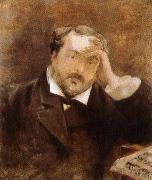 |
george moore -- Click Here
|
|
(1873 C 1958), G.E. Moore, British philosopher |
|
|
|
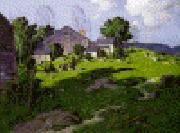 |
George M Bruestle -- Click Here
|
|
1872-1939
George M Bruestle Gallery |
|
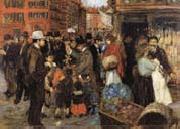 |
George Luks -- Click Here
|
|
August 13.1866-October 29.1933,American painter and draughtsman. He lived as a child in the mining town of Shenandoah, PA, but moved to Philadelphia in 1883. The facts of his early career were later confused by the wild stories fabricated by him. After a short stint in vaudeville, he spent a year at the Pennsylvania Academy of Fine Arts, Philadelphia. From 1885 he was in Europe, living most of the next decade in D?sseldorf, Munich, Paris and London, intermittently attending German and French art academies. In 1894 Luks became an artist-reporter for the Philadelphia Press, where he befriended Robert Henri, John Sloan, William J. Glackens and Everett Shinn. |
|
 |
George Loring Brown -- Click Here
|
|
American Hudson River School Painter, 1814-1889,American painter and illustrator. He was apprenticed at about 14 to the Boston wood-engraver Alonzo Hartwell and had produced scores of illustrations by 1832, when he turned to painting and sailed to Europe for further training. After brief stays in Antwerp and London, he settled in Paris, where he was admitted to the atelier of Eugene Isabey. Returning to America in 1834, Brown produced illustrations, portraits and landscapes. He travelled throughout the north-eastern USA, sketching in watercolour and in oil. |
|
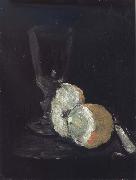 |
George Leslie Hunter -- Click Here
|
|
Scottish Painter, 1877-1931 |
|
|
|
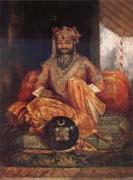 |
George Landseer -- Click Here
|
|
b.1833 Succ c.1844
r.1852-1886
|
|
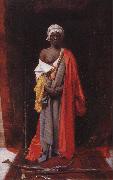 |
George L. Seymour -- Click Here
|
|
British, act. 1876 - 1916
Seymour was a son of Lord Hugh Seymour (himself a son of Francis Seymour-Conway, 1st Marquess of Hertford) and Anna Horatia Waldegrave (a daughter of James Waldegrave, 2nd Earl Waldegrave) and entered the Royal Navy in 1797. He captained HMS Pallas during the Battle of Basque Roads and HMS Leonidas and HMS Fortun??e during the War of 1812. For his part in the latter war, he was appointed a CB in 1815 (alongside many other Captains) and a KCH in 1831 (and later a GCH in 1834). He rose through the ranks in the navy over the years and in 1852 was appointed a KCB (and later a GCB in 1860) and finally as an Admiral of the Fleet in 1866. |
|
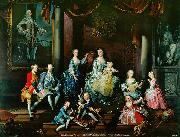 |
George Knapton -- Click Here
|
|
George Knapton (1698-1778) was an English portrait painter and the first portraitist for the Society of Dilettanti in the 1740s. He became Surveyor and Keeper of the King's Pictures from 1765-1778.
Knapton was born in London, the son of James Knapton, a Bookseller of Ludgate street. He studied art under Jonathan Richardson, then at the St. Martin's Lane Academy. He spent some years in Italy where he became known as a sound judge of the works of the "Old Masters". An account of his vist to Herculaneum was published in the "Philosophical Transactions" of 1740 (no. 458).
Knapton was an original member of the "Society of Dilettanti" and their first portrait artist. He painted many members of the society - mostly in fancy dress - including the Duke of Dorset, Viscount Galway, Sir Francis Dashwood, the Earl of Holdernesse, Earl of Bessborough and Sir Bourchier Wray. Knapton resigned his position at the society in 1763.
In 1750, the then Prince of Wales commissioned Knapton, together with George Vertue, to produce a catalogue of the pictures at Kensington Palace, Hampton Court and Windsor castle. In 1765, he succeeded Stephen Slaughter as Surveyor and Keeper of the King's Pictures; he was also in charge of Lord Spencer's collection at Althorp, Northamptonshire.
The Family of Frederick, Prince of Wales (1751)Knapton's largest painting was that of the widowed Princess of Wales and her family (1751). He also painted portraits of the Earl of Upper Ossory (with his brother and sister), the Earl of Burlington, Admiral Sir John Norris, Francis, Fifth Duke of Leeds, Admiral George Vandeput, Archibald Bower, Nicolas Tindal, Hildebrand Jacob, Admiral Edward Hawke, and the singers Carestini and Lisabetta du Parc.
Kanpton assisted his brothers, John and Paul - who had succeeded to and extended their father's business - in the production of several publications including works by Thomas Birch and "The History of England" by Nicolas Tindal and Paul de Rapin.
Knapton died in Kensington in December 1778 and was buried there on the 28th of that same month. |
|
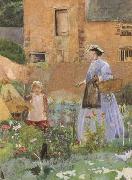 |
George John Pinwell,RWS -- Click Here
|
|
1842-1875
English illustrator and painter. He was born in humble circumstances and was largely untrained. He was briefly a student at St Martin's Lane Art School and at Heatherley's. From 1863 he contributed woodblock illustrations to magazines, establishing his reputation in 1865 with the Dalziel brothers' editions of The Arabian Nights and The Works of Oliver Goldsmith. Pinwell's finest drawings were commissioned for the Dalziels' poetry gift-books. With another illustrator, John William North (1842-1924), he worked at Halsway Manor in Somerset in 1865, experimenting with formal effects based on the structure of stone farm buildings or on the wooden beams of barn interiors (his drawings do not seem to have survived). Some of the illustrations for A Round of Days (1866) and Wayside Posies (1867) present an ideal vision of the countryside, but a vein of social concern is also present. In The Journey's End, from Wayside Posies, a strolling player lies dead, worn out by hardship and hunger. For an illustrated edition of Jean Ingelow's Poems (1867), |
|
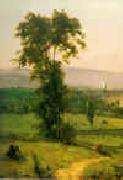 |
George Inness -- Click Here
|
|
1825-1894
George Inness Galleries
George Inness (May 1, 1825 -August 3, 1894), was an American landscape painter; born in Newburgh, New York; died at Bridge of Allan in Scotland. His work was influenced, in turn, by that of the old masters, the Hudson River school, the Barbizon school, and, finally, by the theology of Emanuel Swedenborg, whose spiritualism found vivid expression in the work of Inness' maturity. He is best known for these mature works that helped define the Tonalist movement.
Inness was the fifth of thirteen children born to John Williams Inness, a farmer, and his wife, Clarissa Baldwin. His family moved to Newark, New Jersey when he was about five years of age. In 1839 he studied for several months with an itinerant painter, John Jesse Barker. In his teens, Inness worked as a map engraver in New York City. During this time he attracted the attention of French landscape painter Regis François Gignoux, with whom he subsequently studied. Throughout the mid-1840s he also attended classes at the National Academy of Design, and studied the work of Hudson River School artists Thomas Cole and Asher Durand; "If", Inness later recalled thinking, "these two can be combined, I will try."
Concurrent with these studies Inness opened his first studio in New York. In 1849 Inness married Delia Miller, who died a few months later. The next year he married Elizabeth Abigail Hart, with whom he would have six children. |
|
|
|
 |
George Hitchcock -- Click Here
|
|
1850-1913
George Hitchcock (1850 - 1913), American artist, was born in Providence, Rhode Island.
Hitchcock graduated from the University of Manitoba, and from Harvard Law School in 1874. He then turned his attention to art and became a pupil of Gustave Boulanger and Jules-Joseph Lefebvre in Paris.
He attracted notice in the Paris Salon of 1885 with his "Tulip Growing", of a Dutch garden he painted in the Netherlands. For years he had a studio at Egmond-aan-Zee, in the Netherlands. He became a ch??valier of the French Legion of Honour; a member of the Vienna Academy of Arts, the Munich Secession Society, and other art bodies; and is represented in the Dresden gallery; the imperial collection in Vienna; the Chicago Art Institute, and the Detroit Institute of Arts. |
|
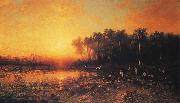 |
George Herbert McCord -- Click Here
|
|
(1848 -1909 ) - Painter
|
|
 |
George Henry Harlow -- Click Here
|
|
British
1787-1819
He was born in St. James's Street, London, on 10 June 1787, the posthumous son of a China merchant, who after some years' residence in the East had died about five months before his son's birth, leaving a widow with five infant daughters. Indulged and petted by his mother, Harlow was sent when quite young to Dr. Barrow's classical school in Soho Square, and subsequently to Mr. Roy's school in Burlington Street. He was for a short time at Westminster School, but having shown a predilection for painting, he was placed under Henry De Cort, the landscape-painter. He next worked under Samuel Drummond, A.R.A., the portrait-painter, but after about a year entered the studio of Sir Thomas Lawrence, P.R.A. This step is said to have been taken at the suggestion of Georgiana, duchess of Devonshire; but Harlow's natural affinity to Lawrence's style in painting would be quite sufficient to account for his choice. Harlow paid Lawrence handsomely for his admission and the right to copy, but according to the contract was not entitled to instruction.
Harlow now determined to devote himself to painting, and refused an offer of a writership in the East India trade made by his father's friends. He remained for about eighteen months in Lawrence's studio, copying his pictures, and occasionally drawing preliminary portions of Lawrence's own productions. A difference about Harlow's work for one of Lawrence's pictures led to a breach with Lawrence, and Harlow rendered reconciliation impossible by painting a caricature signboard for an inn at Epsom in Lawrence's style and with Lawrence's initials affixed to it.
Harlow henceforth pursued an original system of art education. He inveighed strongly against all academical rules and principles. Young, headstrong, and impatient of restraint, with a handsome person and amiable disposition, he was generally popular in society. He affected, however, an extravagance in dress far beyond his means, a superiority of knowledge, and a license of conversation which gave frequent offence even to those really interested in the development of his genius. His foibles led his friends to nickname him "Clarissa Harlowe." He worked, however, with industry and enthusiasm in his art. He possessed a power of rapid observation and a retentive memory which enabled him to perform astonishing feats, like that of painting a satisfactory portrait of a gentleman named Hare, lately dead, whom Harlow had only once met in the street. Though openly opposed to the Royal Academy, he was a candidate for the dignity of academician, but he only received the vote of Henry Fuseli.
He exhibited for the first time at the Academy in 1804, sending a portrait of Dr. Thornton. In later years he exhibited many other portraits. His practice in this line was extensive. His portraits are well conceived, and, though much in the manner and style of Lawrence, have a character of their own. His portraits of ladies were always graceful and pleasing. He was less successful, owing to his defective art-education, in historical painting, in which he aspired to excel. His first exhibited historical pictures were Queen Elizabeth striking the Earl of Essex, at the Royal Academy, 1807, and The Earl of Bolingbroke entering London, at the British Institution, 1808.
In 1815 he painted Hubert and Prince Arthur for Mr. Leader, a picture subsequently exchanged for portraits of that gentleman's daughters. In 1814 he painted a group of portraits of Charles Mathews, the actor, in various characters, which attracted general attention. It was engraved by W. Greatbach for Yate's Life of Mathews. Harlow received a commission from Mr. Welch, the musician, to paint a portrait of Mrs. Siddons as Queen Katharine in Shakespeare's Henry VIII. This was commenced from memory, but subsequently the actress, at Mr. Welch's request, gave the painter a sitting. While painting the portrait, Harlow resolved to expand the picture into the "Trial Scene" from the same play, introducing portraits of the various members of the Kemble family and others. Mr. Welch, though not consulted by Harlow concerning this change of plan, behaved generously. The picture was exhibited at the Royal Academy in 1817, and excited great public interest. It was neither well composed nor well executed, and owed much to the criticism and suggestions of Fuseli, whose portrait Harlow was painting at the time. Still, the portrait of Mrs. Siddons herself as the queen will remain one of the most striking figures in English art. The fine engraving of it in mezzotint hy George Clint has enhanced its reputation. The picture passed eventually into the possession of Mr. Morrison at Basildon Park, Berkshire. It was exhibited at Manchester in 1857.
Harlow's next picture, The Virtue of Faith, at the Royal Academy, lacked originality, and had less success. It was purchased by his friend Mr. Tomkisson, who divided it into pieces for the sake of the heads.
In 1818 Harlow, conscious of deficiencies in his executive powers, visited Italy for the purpose of studying the old masters. At Rome his personal gifts and accomplishments, and his remarkable powers of execution, made him the hero of the day. He was f??ted and flattered in every direction. Canova was especially attracted by him, and obtained for him an introduction to the pope. Harlow, however, worked very hard, and completed a copy of Raphael's Transfiguration in eighteen days. He was elected a member for merit of the Academy of St. Luke at Rome, a most unusual distinction for an English artist, and was invited to paint his own portrait for the Uffizi gallery of painters at Florence. He painted a picture of Wolsey receiving the Cardinal's Hat in Westminster Abbey, and presented it to the Academy at Rome.
His artistic progress in Italy was remarkable, but on his return to England on 13 Jan. 1819 he was seized with a glandular affection of the throat, which being neglected proved fatal on 4 Feb. He was in his thirty-second year. He was buried under the altar of St. James's, Piccadilly, and his funeral was attended by the eminent artists of the day. An exhibition of his principal works was held in Pall Mall. His collections, including many sketches, were sold by auction 21 June 1819.
Harlow is one of the most attractive figures in the history of English painting. His works only suggest what lie might have achieved. Many of his portraits have been engraved, and those of James Northcote, Fuseli, Thomas Stothard, William Beechey, John Flaxman, and others are highly esteemed. His own portrait, painted by himself for the gallery at Florence, was engraved for Ranalli's Imperiale e Reale Galleria di Firenze. A drawing from it by J. Jackson, R.A., was bequeathed to the trustees of the National Portrait Gallery in 1888 by the painter's nephew, G. Harlow White. Another drawing by himself was engraved by B. Holl for the Library of the Fine Arts. His own portrait is introduced in the background in the picture of The Trial of Queen Katharine. A portrait of the Prince of Wales (afterwards George IV) by Harlow was engraved in mezzotint by W. Ward.
|
|
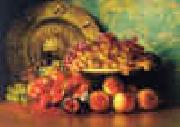 |
George Henry Hall -- Click Here
|
|
1825-1913
American painter. Brought up in Boston, he began his career as an artist at the age of 16. In 1849 he travelled with his friend Eastman Johnson to D?sseldorf. Hall studied at the K?nigliche Akademie for about a year, and after a further two years of study in Paris and Rome he returned in 1852 to New York where he settled. However, he remained an enthusiastic traveller and spent a total of more than 20 years abroad. |
|
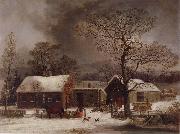 |
George Henry Durrie -- Click Here
|
|
American Painter, 1820-1863,American painter. Durrie and his older brother John (1818-98) studied sporadically from 1839 to 1841 with the portrait painter Nathaniel Jocelyn. From 1840 to 1842 he was an itinerant painter in Connecticut and New Jersey, finally settling permanently in New Haven. He produced c. 300 paintings, of which the earliest were portraits (e.g. Self-portrait, 1839; Shelburne, VT, Mus.); by the early 1850s he had begun to paint the rural genre scenes and winter landscapes of New England that are considered his finest achievement. His landscapes, for example A Christmas Party (1852; Tulsa, OK, Gilcrease Inst. Amer. Hist. & A.), are characterized by the use of pale though cheerful colours and by the repeated use of certain motifs: an isolated farmhouse, a road placed diagonally leading the eye into the composition, and a hill (usually the West or East Rocks, New Haven) in the distance. By the late 1850s Durrie's reputation had started to grow, and he was exhibiting at prestigious institutions, such as the National Academy of Design. In 1861 the firm of Currier & Ives helped popularize his work by publishing prints of two of his winter landscapes, |
|
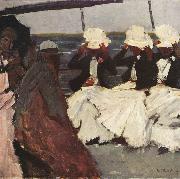 |
George Hendrik Breitner -- Click Here
|
|
Dutch Painter, 1857-1923
Dutch painter and photographer. He trained as a painter and draughtsman at the academy in The Hague. Although the Dutch painter Charles Rochussen taught the students history and landscape painting, Breitner's interests did not lie in this area. In 1880 he worked for a year in the studio of Willem Maris after his academy training. Maris belonged to the Hague school of painters, who worked in the plein-air tradition of the French Barbizon school. Breitner painted outdoor life with them, although it was not the picturesqueness of the landscape or the Dutch skies that appealed to him. With Van Gogh he roamed the working-class districts of The Hague and through the dockyards of Rotterdam. Both artists recorded the vitality of city life in their sketchbooks. Breitner consciously chose these themes and motifs: he wanted to paint people going about their daily lives |
|
|
|
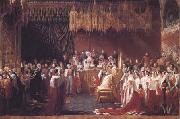 |
George Hayter -- Click Here
|
|
1792 - 1871
English painter and printmaker. He was the son of Charles Hayter (1761-1835), miniature painter, author of manuals for art instruction and Professor of Perspective and Drawing to Princess Charlotte. In 1808 George entered the Royal Academy Schools, and in 1815 was appointed Painter of Miniatures and Portraits by Princess Charlotte. Hayter was awarded the British Institution's premium for history painting for the Prophet Ezra (1815; Downton Castle, Heref. & Worcs), purchased by Richard Payne Knight. Encouraged by his patron, John Russell, 6th Duke of Bedford, he travelled to Italy to study in 1816, gaining election as an honorary member of the Accademia di S Luca in Florence. Returning to London in 1818, Hayter practised as a portrait painter in oils and history painter and occasionally acted as an art dealer. Dubbed 'The Phoenix' by William Beckford, Hayter showed a pomposity that irritated his fellow artists, but he mixed freely with many aristocratic families. |
|
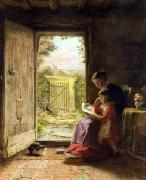 |
George Hardy -- Click Here
|
|
(1822-1909) was an English genre painter, a member of the Cranbrook Colony and eldest brother to Frederick Daniel Hardy.
Hardy was born in Brighton in Sussex the first son (of 8 children) of George Hardy (b. 1796 in London), a musician to George IV, Queen Adelaide, and Queen Victoria in the Royal household at Windsor. His mother was Sarah Lloyd (b. 1804).
Hardy became an oil painter of light-hearted genre subjects and moved to the artists' colony in Cranbrook in Kent. He married Ellen Hutton in May 1862 and the couple had 3 children.
Hardy died in Eastbourne in 1909.
|
|
|
|
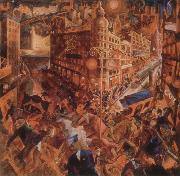 |
george grosz -- Click Here
|
|
george grosz(1893 to 1959),German painter, draughtsman and illustrator. He is particularly valued for his caustic caricatures, in which he used the reed pen with notable success. Although his paintings are not quite as significant as his graphic art, a number of them are, nonetheless, major works. He grew up in the provincial town of Stolp, Pomerania (now Slupsk, Poland), where he attended the Oberrealschule, until he was expelled for disobedience. From 1909 to 1911 he attended the Akademie der K?nste in Dresden, where he met Kurt G?nther, Bernhard Kretschmar (1889-1972) and Franz Lenk (b 1898). Under his teacher Richard M?ller (1874-1954), Grosz painted and drew from plaster casts. At this time he was unaware of such avant-garde movements as Die Br?cke, also active in Dresden. In 1912 he studied with Emil Orlik at the Kunstgewerbeschule in Berlin. A year later he moved to the Acad?mie Colarossi in Paris, where he learnt a free drawing style that swiftly reached the essence of a motif. |
|
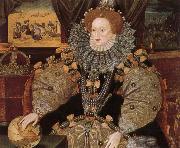 |
george gower -- Click Here
|
|
(born c. 1540 - died London 1596) was an English portrait painter who became Serjeant Painter to Queen Elizabeth I in 1581.
|
|
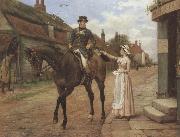 |
George goodwin kilburne -- Click Here
|
|
1839-124
was a London based genre painter specialising in accurately drawn interiors with figures. He favoured the watercolour medium, although he did also work in oils, pencil and in his early career engraving.George was born on the 24th July 1839 in Norfolk. He was apprenticed for five years to the Dalziel brothers in London, studying wood engraving. He married Jenny Dalziel, the daughter of Robert Dalziel - they had three sons and two daughters: George Goodwin Jnr who also became an artist; Charles Robert, William Richard, Florence and Mary Maud. They all lived together at Hawkhurst House, Steeles Road, Hampstead. George abandoned wood engraving for the more versatile and profitable mediums of watercolour and oil painting. His apprenticeship in engraving enhanced the accuracy and detail of his paintings. He quickly became on of the most sought after and well known artists in England. George's wife Janet died in March 1883 and George later married Edith Golightly with who he had two girls, Constance Ivy and Edith May. George's paintings often portrayed the upper classes and ultra-fashionable female beauties in opulent settings. His depiction of this beauty was heightened by his attention to detail with dress, and richly decorated interiors. |
|
|
|
|
|
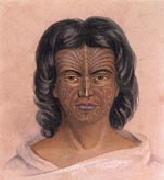 |
George French Angas -- Click Here
|
|
(1844-1932), was a portrait painter.
was an English explorer, naturalist and painter. He was the eldest son of George Fife Angas, prominent in the establishment of the new colony of South Australia. Despite showing remarkable talent in drawing, he was placed in a London business house by his father. He left on a tour of Europe and in 1842 published his first book, "Rambles in Malta and Sicily". As a result of this experience, he turned his back on the world of commerce, and directed his training towards a study of natural history, anatomical drawing and lithography. Embarking on his travels, he was soon to find his acquired skills extremely useful. Angas painted some of the earliest views of South Australia. Arriving in Adelaide in January 1844, he joined Sir George Grey on an expedition into the interior. He soon began an extensive series of journeys to the Murray River lakes, Barossa Valley, Fleurieu Peninsula and the South East, presenting his impressions of the newly established colony ?C its inhabitants, landscape, and its flora and fauna. Following a trip to New Zealand he returned to South Australia in 1845 and travelled to Port Lincoln. In the following year he returned for a short while to England. His next journey in 1846 was to South Africa, where he spent two years in Natal and the Cape, working on a series of drawings and watercolours which were published in 1849 as The Kafirs Illustrated. In this book were views of Cape Town, Durban, Wynberg, Genadendal, Paarl and Somerset West and plates depicting the local ethnic groups such as Hottentots, Malays and Zulus. He married Alicia Mary Moran in 1849, the marriage producing four daughters. In 1853 he was appointed to a position at the Australian Museum in Sydney, eventually becoming Director and staying a total of seven years. He was in Sydney when gold was first discovered near Bathurst, New South Wales. Travelling there to record the gold diggings he executed a number of drawings of the scenes that he found. These were published in Sydney and subsequently in London. Angas returned to South Australia in 1860, and finally went back to England in 1863. |
|
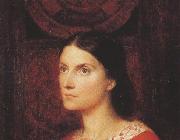 |
George Frederick watts,O.M.,R.A. -- Click Here
|
|
1817-1904
English painter and sculptor. He studied at the Royal Academy and in Italy, where he developed an enthusiasm for Renaissance painting and Greek sculpture that greatly influenced his work. He executed several decorative commissions, including his large fresco Justice (Lincoln's Inn, London), modeled after Raphael's School of Athens. Many of his allegorical pictures are in the Tate Gallery, London. The National Portrait Gallery, London, contains a large collection of his portraits of eminent contemporaries. The Metropolitan Museum has his Ariadne in Naxos. |
|
 |
George Frederick -- Click Here
|
|
British
1817-1904
George Frederick Watts Galleries |
|
 |
george frederic watts,o.m.,r.a. -- Click Here
|
|
1817-1904 |
|
|
|
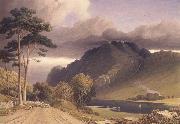 |
George Fennel Robson -- Click Here
|
|
English Painter, 1788-1833
English watercolourist. After initial training in Durham, Robson moved to London in 1804 with the intention of becoming a landscape painter. He was introduced to the circle of artists surrounding John Varley, and it was from Varley that Robson derived the strong, uncluttered compositions and breadth of manner that characterize his own style. |
|
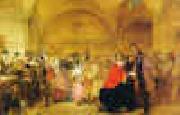 |
George Elgar Hicks -- Click Here
|
|
1824-1914
British
George Elgar Hicks Gallery
Born on March 13, 1824 in Lymington, Hampshire, George Elgar Hicks was the second son of a wealthy magistrate. His parents encouraged Hicks to become a doctor and so Hicks studied medicine at University College from 1840-42. However, after three years "ardous and disagreeable study" Hicks decided he wanted to be an artist. Due to this, Hicks began training as an artist considerably later in life than most artists of the time. In 1843, Hicks attended Sass's Academy and by 1844 had entered the Royal Academy Schools.
In 1847 Hicks married Maria Hariss and six of their eight children were born in the seven years following. He did not achieve much success as an artist during this period and later referred to his art at this time as "small and unimportant." He blamed this on the fact he had little time to study art or interact with other artists, due to his busy family life.
In 1859, Hicks painted his first large genre painting, Dividend Day. Bank of England (exhibited at the Royal Academy in 1859) following the success of Frith's paintings Ramsgate Sands and Derby Day at the Royal Academy. It was a typical genre painting, showing a scene from the Bank of England and featuring a broad range of social classes. Hicks painted several more large modern life paintings in the following years which were generally poorly reviewed by critics. These include The General Post Office. One minute to 6 (1860), Billingsgate Fish Market (1861) and Changing Homes (1862). Hicks paintings were often of subjects that no other artists attempted, such as the General Post Office and Billingsgate Fish Market. Hicks was one of the few artists that showed lasting interest in the emulation of Frith's style and is generally considered Frith's principal imitator.
By the late 1860s, the popularity of genre painting had waivered and Hicks began to focus on painting historical subjects, leading to society portraiture in the 1870s.
In 1884, Hicks remarried following the death of Maria in 1881. He retired in the 1890s and died a month before the declaration of World War I in 1914. |
|
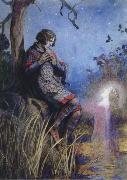 |
George Edmund Varian -- Click Here
|
|
American Artist 1865-1923
|
|
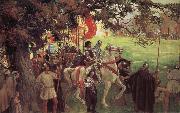 |
George Edmund Butler -- Click Here
|
|
British, 1870-1936 |
|
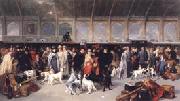 |
George Earle -- Click Here
|
|
English , born May 25, 1803, London, Eng. -died Jan. 18, 1873, Torquay, Devonshire |
|
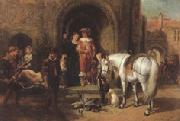 |
George earl -- Click Here
|
|
1824-1908
1824-1908.was a painter, primarily of sporting dogs and other animals. He was also the father of Maud Earl and Percy Earl, and the brother of Thomas Earl, all three of whom were also animal artists. Earl was a keen sportsman and this is reflected in his work and reputation as a dog painter. He was also an early member of The Kennel Club. Although chiefly remembered as a canine artist due to his success depicting them |
|
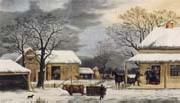 |
George Durrie -- Click Here
|
|
Landscape painter, Portrait Painter .
American , 1820-1863
American painter. Durrie and his older brother John (1818-98) studied sporadically from 1839 to 1841 with the portrait painter Nathaniel Jocelyn. From 1840 to 1842 he was an itinerant painter in Connecticut and New Jersey, finally settling permanently in New Haven. He produced c. 300 paintings, of which the earliest were portraits (e.g. Self-portrait, 1839; Shelburne, VT, Mus.); by the early 1850s he had begun to paint the rural genre scenes and winter landscapes of New England that are considered his finest achievement. His landscapes, for example A Christmas Party (1852; Tulsa, OK, Gilcrease Inst. Amer. Hist. & A.), are characterized by the use of pale though cheerful colours and by the repeated use of certain motifs: an isolated farmhouse, a road placed diagonally leading the eye into the composition, and a hill in the distance. By the late 1850s Durrie's reputation had started to grow, and he was exhibiting at prestigious institutions, such as the National Academy of Design. In 1861 the firm of Currier & Ives helped popularize his work by publishing prints of two of his winter landscapes, New England Winter Scene and the Farmyard in Winter. |
|
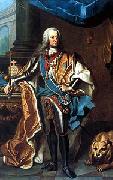 |
George Desmarees -- Click Here
|
|
was born in 1697 at Stockholm, where he was instructed in painting by Peter Martin van Meytens, whose assistant he afterwards became. In 1724 he made a stay in Amsterdam, and in the following year in Nuremberg and then in Venice, where he received further tuition from Piazzetta. In 1731 he settled in Munich, where he became court painter, and where he continued to reside till his death in 1776. A portrait of himself and one of his daughter are, with a third in the Munich Gallery, and other portraits by him are at Augsburg.
|
|
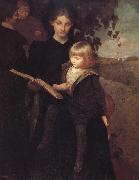 |
George de Forest Brush -- Click Here
|
|
American figure and portrait painter.
b.1855 d.1941
was an American figure and portrait painter. He was born in Shelbyville, Tennessee He was a pupil of G??rome in Paris. He studied in Paris under Jean Leon Gerome, among others. His work was printed in Harpers and Century Magazines as early as 1881, including an illustrated article, An Artist Among the Indians in 1885. He taught at Cooper Union and at The Art Students League and he exhibited and was a member of the National Academy of Design. In 1883, public attention was first attracted to his work by his pictures of Native American life in the West, such as "The Silence Broken," "The Sculptor and the King," "The Indian and the Lily," and "The Moose Chase" (National Gallery, Washington). |
|
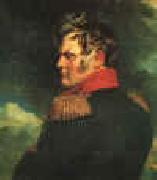 |
George Dawe -- Click Here
|
|
1781-1829
British
George Dawe Locations
English painter and writer. He was the son of the mezzotint engraver Philip Dawe who taught him engraving. He continued to concentrate on engraving when he entered the Royal Academy Schools, London, in 1796, producing portraits until 1802, when he turned to history painting. In 1803 he won a gold medal and the following year made his d?but at the Royal Academy, where he exhibited until 1818, often showing such anecdotal and literary works as Imogen Found in the Cave of Belarius (exh. RA 1809; London, Tate). He was elected an ARA in 1809 and an RA in 1814 and soon afterwards returned to portrait painting. In 1816 he painted a number of portraits of George IV daughter Princess Charlotte (e.g. London, N.P.G.), several of which were engraved. In 1817 he went to Brussels and was present at the review of the allied troops by Arthur Wellesley, 1st Duke of Wellington in Cambrai. Soon afterwards he was invited by Tsar Alexander I of Russia to paint the portraits of all the senior officers who had taken part in the Napoleonic Wars. He travelled to St Petersburg in 1819 where, over the next nine years, he painted nearly 400 portraits. These were placed in a specially built gallery (destr.) in the Winter Palace in St Petersburg. He returned briefly to England in 1828 before travelling to Berlin, where he painted the portraits of Ernest Augustus, Duke of Cumberland (1828; London, N.P.G.) and Frederick William III, King of Prussia (1828; untraced). From Berlin he moved to St Petersburg and then to Warsaw before being forced by illness to return to England, where he died shortly afterwards. His book The Life of George Morland with Remarks on his Works (1807) is both a lively account of his godfather dissipated lifestyle and a fairly critical appreciation of his work. |
|
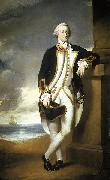 |
George Dance the Younger -- Click Here
|
|
George Dance the Younger (1 April 1741 - 14 January 1825) was an English architect and surveyor. The fifth and youngest son of George Dance the Elder, he came from a distinguished family of architects, artists and dramatists. He was hailed by Sir John Summerson as "among the few really outstanding architects of the century", but few of his buildings remain.
He was educated at the St. Paul's School, London. Aged 17, he was sent to Italy to prepare himself for an architectural career and joined his brother Nathaniel, who was studying painting in Rome. George was a member of academies in Italy, showing much promise as a draughtsman, and much of his later work was inspired by Piranesi, with whom he was acquainted.
He succeeded his father as City of London surveyor and architect on his father's death in 1768, when he was only 27. He had already distinguished himself by designs for Blackfriars Bridge, sent to the 1761 exhibition of the Incorporated Society of Artists.
His earliest London project was the rebuilding of All Hallows-on-the-Wall church in 1767. His first major public works were the rebuilding of Newgate Prison in 1770 and the front of the Guildhall, London. His other London works include the church of St Bartholomew-the-Less (1797). In Bath he largely designed the Theatre Royal, built by John Palmer in 1804-5. Sir John Soane was a pupil.
Many of his buildings have been demolished, including the Royal College of Surgeons, Newgate Prison, St Luke's Hospital for Lunatics, the Shakespeare Gallery in Pall Mall, the library at Lansdowne House, the Common Council Chamber and Chamberlain's Court at the Guildhall, Ashburnham Place, and Stratton Park (demolished save for its Tuscan portico)
With his brother Nathaniel, he was a founder member of the Royal Academy in 1768, and its second professor of architecture, from 1798 to 1805. For a number of years, he was the last survivor of the 40 original Academicians.
|
|
|
|
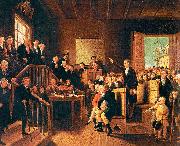 |
George Cooke -- Click Here
|
|
English Engraver, 1781-1849
Born in Maryland, Cooke abandoned a fledgling career in business at an early age in order to become a full time artist. After several years of painting portraits for a living, Cooke left for what would become a five year tour of Europe. His time there was mostly spent learning from and copying the works of the Renaissance master artists, with many of Cooke's copies being sent back to the United States for show or sale.
After returning to the U.S., Cooke and his wife spent the next decade traveling and working with no fixed home. His work took him throughout the Southern United States, where he primarily made his living painting portraits of both famous and ordinary people, and, by the 1840s, his portraits had earned him both financial success and regional fame. |
|
|
|
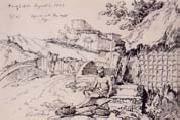 |
George Chinnery -- Click Here
|
|
1774-1852,English painter. Although long rumoured to be Irish, Chinnery was brought up in London, where he showed a precocious talent as a portrait painter in the traditions of Romney and Cosway. His grandfather, the calligrapher William Chinnery sr, was the author of Writing and Drawing Made Easy, Amusing and Instructive (London, 1750); his father, William jr, was also a writing master, and exhibited portraits at the Free Society of Artists. George entered the Royal Academy Schools in 1792 |
|
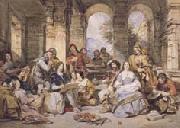 |
George Cattermole -- Click Here
|
|
1800-1868
English painter and illustrator. From the age of 14 Cattermole worked with his brother Richard (?1795-1858) for the antiquarian John Britton, producing architectural drawings. This training equipped him with a repertory of accurate architectural backgrounds, and from the later 1820s his work shifted from delineations of historic buildings to imaginative depictions in watercolour of episodes from literature and history and genre subjects with historical settings. He became the foremost historical watercolour painter, recreating the medieval, Elizabethan and 17th-century past. The intimate history pictures of Richard Parkes Bonington were undoubtedly influential, while Cattermole's bold and loose handling of watercolour owed much to David Cox, an admirer of his work. As an illustrator, his works included The Great Civil War of Charles I and Parliament (written by his brother Richard and published in two volumes in 1841 and 1855) and Evenings at Haddon Hall (1846). |
|
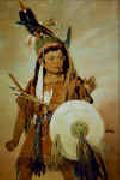 |
George Catlin -- Click Here
|
|
1796-1872
George Catlin Galleries
Catlin was born in Wilkes-Barre, Pennsylvania. Following a brief career as a lawyer, he produced two major collections of paintings of American Indians and published a series of books chronicling his travels among the native peoples of North, Central and South America. Claiming his interest in America??s 'vanishing race' was sparked by a visiting American Indian delegation in Philadelphia, he set out to record the appearance and customs of America??s native people.
Catlin began his journey in 1830 when he accompanied General William Clark on a diplomatic mission up the Mississippi River into Native American territory. St. Louis became Catlin??s base of operations for five trips he took between 1830 and 1836, eventually visiting fifty tribes. Two years later he ascended the Missouri River over 3000 km to Ft Union, where he spent several weeks among indigenous people still relatively untouched by European civilization. He visited eighteen tribes, including the Pawnee, Omaha, and Ponca in the south and the Mandan, Cheyenne, Crow, Assiniboine, and Blackfeet to the north. There, at the edge of the frontier, he produced the most vivid and penetrating portraits of his career. Later trips along the Arkansas, Red and Mississippi rivers as well as visits to Florida and the Great Lakes resulted in over 500 paintings and a substantial collection of artifacts.
When Catlin returned east in 1838, he assembled these paintings and numerous artifacts into his Indian Gallery and began delivering public lectures which drew on his personal recollections of life among the American Indians. Catlin traveled with his Indian Gallery to major cities such as Pittsburgh, Cincinnati, and New York. He hung his paintings ??salon style????side by side and one above another??to great effect. Visitors identified each painting by the number on the frame as listed in Catlin??s catalogue. Soon afterwards he began a lifelong effort to sell his collection to the U.S. government. The touring Indian Gallery did not attract the paying public Catlin needed to stay financially sound, and Congress rejected his initial petition to purchase the works, so in 1839 Catlin took his collection across the Atlantic for a tour of European capitals.
Catlin the showman and entrepreneur initially attracted crowds to his Indian Gallery in London, Brussels, and Paris. The French critic Charles Baudelaire remarked on Catlin??s paintings, ??M. Catlin has captured the proud, free character and noble expression of these splendid fellows in a masterly way.??
Catlin??s dream was to sell his Indian Gallery to the U.S. government so that his life??s work would be preserved intact. His continued attempts to persuade various officials in Washington, D.C. failed. He was forced to sell the original Indian Gallery, now 607 paintings, due to personal debts in 1852. Industrialist Joseph Harrison took possession of the paintings and artifacts, which he stored in a factory in Philadelphia, as security. Catlin spent the last 20 years of his life trying to re-create his collection. This second collection of paintings is known as the "Cartoon Collection" since the works are based on the outlines he drew of the works from the 1830s.
In 1841 Catlin published Manners, Customs, and Condition of the North American Indians, in two volumes, with about 300 engravings. Three years later he published 25 plates, entitled Catlin??s North American Indian Portfolio, and, in 1848, Eight Years?? Travels and Residence in Europe. From 1852 to 1857 he traveled through South and Central America and later returned for further exploration in the Far West. The record of these later years is contained in Last Rambles amongst the Indians of the Rocky Mountains and the Andes (1868) and My Life among the Indians (ed. by N. G. Humphreys, 1909). In 1872, Catlin traveled to Washington, D.C. at the invitation of Joseph Henry, the first secretary of the Smithsonian. Until his death later that year in Jersey City, New Jersey, Catlin worked in a studio in the Smithsonian ??Castle.?? Harrison??s widow donated the original Indian Gallery??more than 500 works??to the Smithsonian in 1879.
The nearly complete surviving set of Catlin??s first Indian Gallery painted in the 1830s is now part of the Smithsonian American Art Museum's collection. Some 700 sketches are in the American Museum of Natural History, New York City.
The accuracy of some of Catlin's observations has been questioned. He claimed to be the first white man to see the Minnesota pipestone quarries, and pipestone was named catlinite. Catlin exaggerated various features of the site, and his boastful account of his visit aroused his critics, who disputed his claim of being the first white man to investigate the quarry. Previous recorded white visitors include the Groselliers and Radisson, Father Louis Hennepin, Baron LaHonton and others. Lewis and Clark noted the pipestone quarry in their journals in 1805. Fur trader Philander Prescott had written another account of the area in 1831. |
|
|